
Konstantinos Gerardos
Is a dancer teacher, choreographer and the artistic director of VIS MOTRIX DANCE COMPANY, which is based in Thessaloniki/Greece. He runs VIS MOTRIX PERFORMANCE STUDIO, a space for contemporary dance, performance and theatre in Thessaloniki and he is the creator and educational director of ReDance, an educational program in contemporary dance and performance for actors and dancers.
He started dancing at the National School of Dance in Athens when he was 11 years old. He continued his studies at the Morianova Professional Dance School and graduated from the Professional Dance School of Stavroupoli in Thessaloniki.
Between 1989 and 2004 he danced for the Thessaloniki Dance Theatre (National Theatre of Northern Greece). In 2001 he won the 1st prize at the National Awards for Dance for his interpretation as ‘Bluebeard’ at the performance of the same name, directed by K. Rigos. In 2012 he was invited by the ‘Machinenoisy Dance Company’ based in Vancouver, Canada to dance at the performance ‘Romantic Old Horses’ directed by Peter Bingham. His career as a dancer has continued until today.
In 2001, he founded his own company, ‘VIS MOTRIX DANCE COMPANY’ based at the Vis Motrix Performance Studio in Thessaloniki and has been creating and directing its performances (In Dreams, Safety Distance, Pessoas, In Between, Nocturne, Void, Dark Matter(s) and others) in Greece and abroad (Great Britain, Germany, Spain). In May 2015 Konstantinos Gerardos directed the performance ‘TAN’ for the Thessaloniki Dance Theater (National Theatre of Northern Greece). He has also worked as an actor for the ‘Nees Morfes’ Theatre Company and as a choreographer for theatre and opera and has been subsidized for his work by the Greek Ministry of Culture.
During his work as a dancer and choreographer for the past 30 years, Konstantinos Gerardos has also developed a great teaching experience in classical and contemporary dance, improvisation and Contact Improvisation, Partnering, Ensemble Improvisation, composition, choreography and performance in professional dance schools and acting schools. He has taught improvisation and choreography at the Dance and Performance course at the University of Lincoln in England and workshops in contemporary dance and contact improvisation in Spain, Germany, Israel and Canada. He has collaborated with Chris Aiken, Angie Houser Kirstie Simpson, Nita Little, Ray Chung, Eckhard Muller, Gregor Weber, Thomas Mettler, Yaniv Mintzer and many others.

LEANING TO THE UNKNOWN
KEY WORDS: CI – SKILLS - IMPROVISATION
There many reasons to improvise: warming up, creating specific movement for choreography, bonding groups of people together, exploring new movement qualities, achieving a particular somatic state, creating a performance. In this intensive, we will attend to the use of improvisation as material to enrich our contact improvisation skills and improve the quality of touch and movement in contact with another dancer.
During our work together, we will zoom into the tangible body and its physiology, skin, soft tissue, muscles and bones to inspire our dance. Working solo and in contact we will clarify their role in our personal way of moving and in contact improvisation. Isometric positions will clarify the use of our muscles and playing with the soft tissue of our bodies solo and in contact will enrich the sensitivity of our perception through the skin. We will study the architecture, function and movement qualities of specific body parts like the spine, the hip joints, the torso, the pelvis or the extremities to improve our skills when we are in contact with our partner. Exploring different ways of rolling, sliding, on or off the floor and using the floor as well as a partner to support our travelling through space will bring light and clarify our relationship with space, time and gravity.
Starting from the known we will find the tracks to the unknown, starting from the familiar and the reliable we will travel to the unanticipated and the unpredictable. Starting from our own bodies (solo) we will investigate the elements of improvisation that will help us to improve our improvisational awareness, the ability of listening, not only to our own body but also our partner's body and to experience a dance that is born from our mutual surrendering to each other using improvisation as a tool.